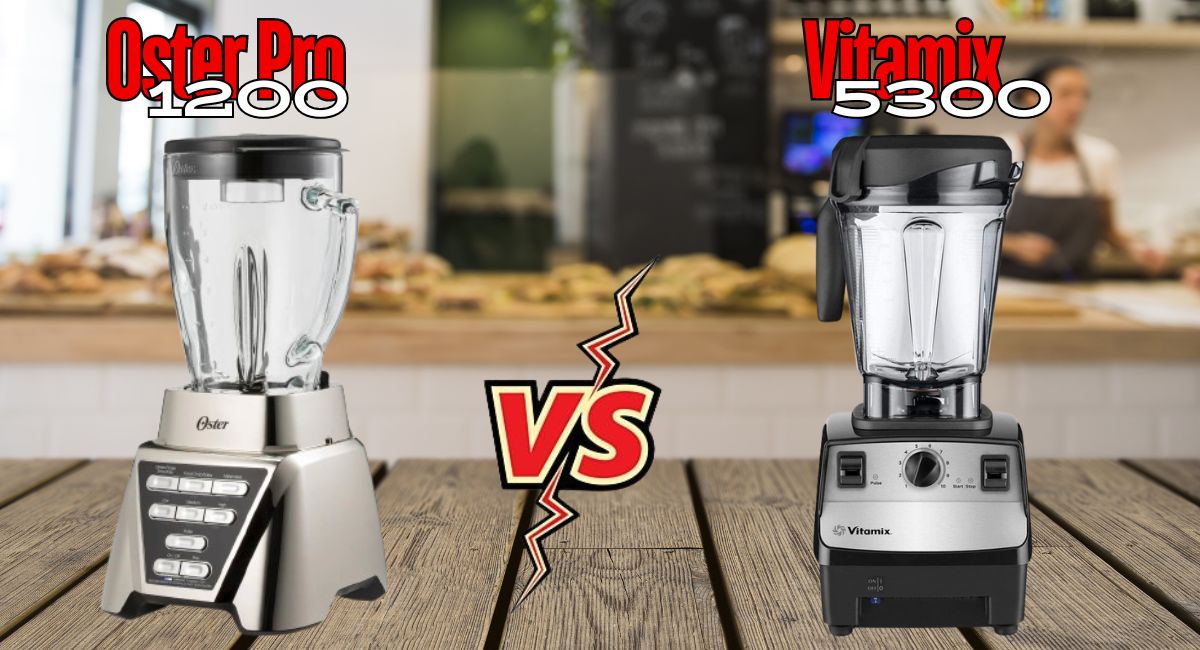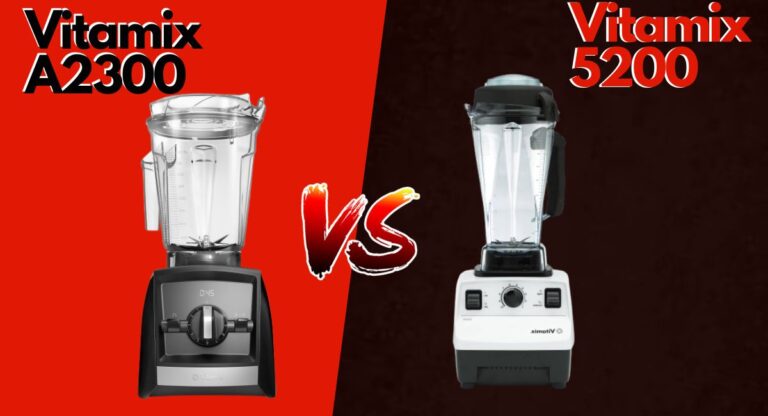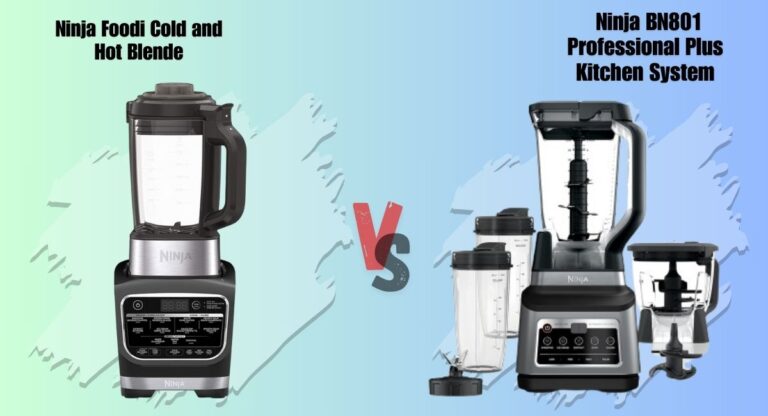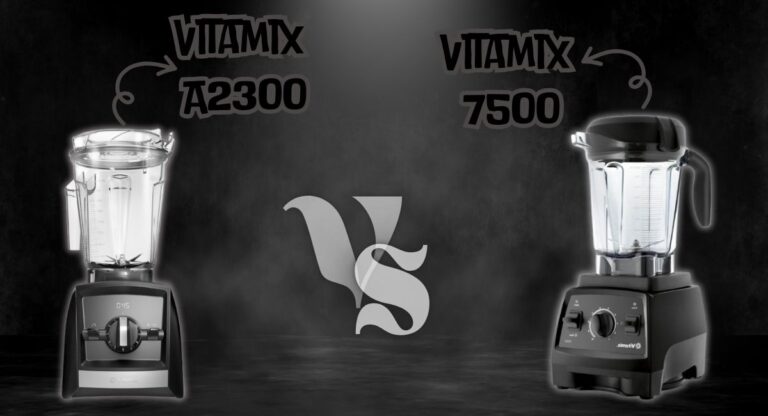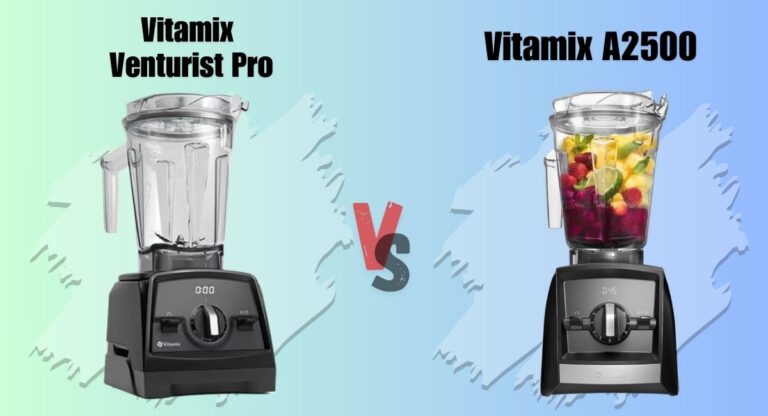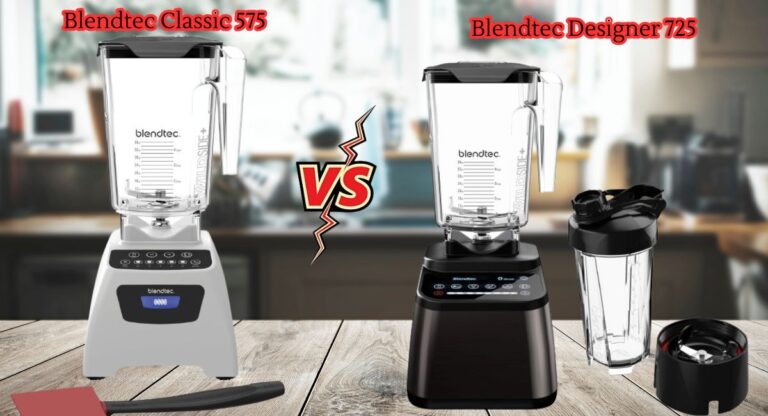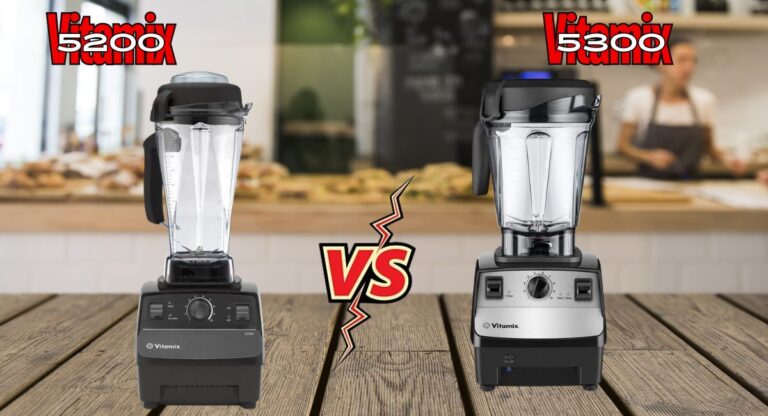Oster Pro 1200 vs Vitamix 5300 – Side By Side Comparison
We’re pitting two of the most popular blenders on the market against each other: the Oster Pro 1200 and the Vitamix 5300. Both blenders promise to deliver silky-smooth results, but which one comes out on top?
When it comes to choosing a blender, there are a lot of factors to consider. You want a blender that’s powerful, easy to use, and easy to clean. You also want a blender that can handle a variety of ingredients, from frozen fruits to hot soups.
In this side-by-side comparison, we’ll explore the key features, performance, and overall value of these two blenders. Also, tell you pros, and cons of each blender to help you make an informed decision. Whether you’re looking for a budget-friendly option or a high-end powerhouse, this guide will help you decide which blender is the best fit for your kitchen needs.
Overall Size Comparison
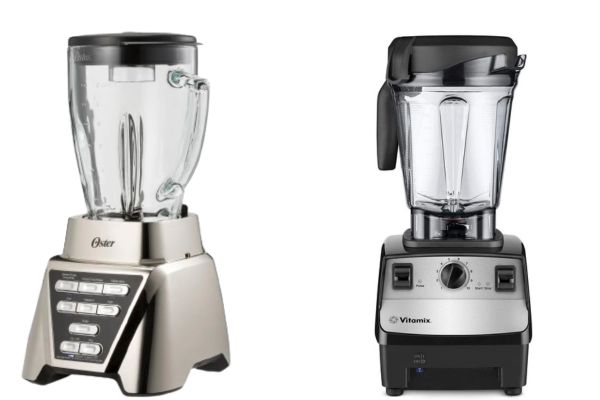
When it comes to size, the Oster Pro 1200 blender is a compact powerhouse that’s perfect for kitchens with limited space. It’s a relatively short blender, standing at just 14.4 inches tall, making it one of the smaller full-size blenders on the market. This is great news for those who don’t have a lot of room to spare, as it can fit comfortably on most countertops without taking up too much space.
But what really makes the Oster blender stand out is its slender design. With a width of just 7.0 inches and a depth of 7.5 inches, it can fit snugly on your countertop, leaving you with plenty of space to work on other dishes. Plus, its compact size makes it a breeze to store, whether you prefer to keep it on your countertop or stash it away in a cupboard. You can easily tuck it away when you’re not using it, or leave it out on display without feeling cluttered.
One of the biggest advantages of the Oster 1200 watt blender’s compact size is its lightweight design. Weighing in at just 7.9 pounds, it’s easy to move and store, even for those who may not have a lot of strength or mobility. This makes it perfect for a variety of scenarios, from small apartments to RVs or campers, where space is limited and every inch counts. You can easily take it with you on the go, or store it away in a small cupboard when you’re not using it.
On the other hand, the Vitamix 5300 is a larger blender that’s designed for those who need a bit more power and capacity. It’s slightly shorter than the Vitamix 5200, measuring 17.2 inches in height, but it’s a touch wider at 7.6 inches and a bit deeper at 9 inches. This means it’s still a bit of a space-taker, but it’s not as massive as some of the other blenders on the market. It weighs slightly more than the 5200 at 11.5 pounds, which can make it a bit more difficult to move around.
Before you bring the Vitamix 5300 home, it’s essential to consider the space you have available. You’ll want to make sure you have a spot on your countertop where it can sit comfortably, or a large cupboard that can accommodate its size. If space is tight, you can remove the main jar to make storage a bit easier, but this doesn’t change the fact that it’s a larger and heavier blender that requires some planning when it comes to storage.
Jar Material & Capacity Comparison
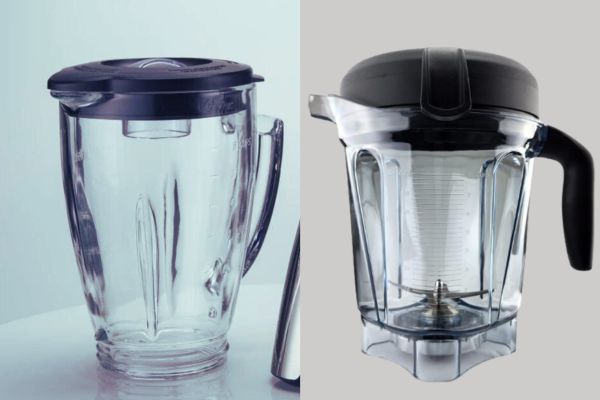
When it comes to blending capacity, the Vitamix 5300 takes the lead with its massive 64-ounce jar. This means you can make larger batches of your favorite smoothies or soups without having to blend multiple times. In contrast, the Oster’s main jar has a 48-ounce capacity, which is on the smaller side for a full-size blender. However, the Oster makes up for this by including a 24-ounce personal jar, perfect for making individual servings or blending small batches.
Now, let’s talk about the materials used in these jars. The Oster’s main jar is made of glass, which is a great choice because it’s less prone to scratches and discoloration than plastic. This means your blender will look like new for a longer period, and you won’t have to worry about any funky flavors or odors seeping into your blends. On the other hand, the Vitamix 5300’s jar is made of plastic, which may not be as durable or resistant to scratches.
Another important consideration is cleaning. With the Oster, you can breathe a sigh of relief because both jars, the blades, and the lids are dishwasher-safe. This makes cleaning up a breeze, saving you time and effort. Unfortunately, the Vitamix 5300 doesn’t offer the same convenience. None of its components are dishwasher-safe, which means you’ll have to wash them by hand.
Lastly, if a personal jar is a must-have for you, the Oster is the clear winner. Its 24-ounce personal jar is perfect for making individual servings or blending small batches. If you’re looking for a similar feature in a Vitamix blender, you might want to consider the Nutribullet Full-Size Blender Combo 1200W, which comes with a personal jar.
LID Design & Material Comparison
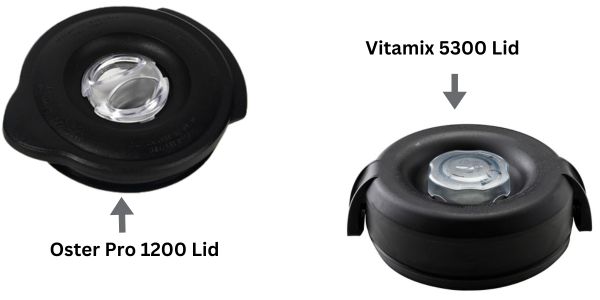
The 1200 Pro’s main jar has a two-part lid that’s designed to make your blending experience more convenient. The clear centerpiece of the lid can be removed, allowing you to add ingredients mid-blend without having to stop the machine. This is a great feature for those who like to tweak their recipes on the fly or add a little extra something to their blends.
Additionally, the personal jar comes with a resealable to-go lid that screws onto the jar, making it perfect for taking your blends on the go. However, the cover for the spout feels a bit flimsy, which might be a concern for some users.
On the other hand, the Vitamix blender’s two-part lid uses friction to stay shut, which means it doesn’t have any latches or clips to worry about. Instead, the lid has two ears on each side that hook underneath the lip of the main jar to hold it in place. This design ensures a secure fit, and you can be confident that your lid will stay put even during intense blending sessions.
One of the best features of the Vitamix 5300’s lid is the ability to remove the middle section, allowing you to add ingredients or use the tamper to push food closer to the blades. This makes it easy to get the most out of your blender and ensures that all your ingredients are fully incorporated.
However, there’s one drawback to the Vitamix’s lid: it’s not dishwasher-safe. You’ll need to wash it by hand, which might be a bit of a hassle for some users. On the other hand, the Nutribullet 1200 Pro’s lid is dishwasher-safe, making cleaning up a breeze.
In terms of overall design, both lids are well-thought-out and offer unique features that enhance the blending experience. However, the Vitamix 5300’s lid feels more secure and durable, thanks to its friction-based design and sturdy construction. The Oster pro 1200’s lid, on the other hand, is more convenient and easy to use, with its removable centerpiece and resealable to-go lid.
Motor Built Quality Comparison
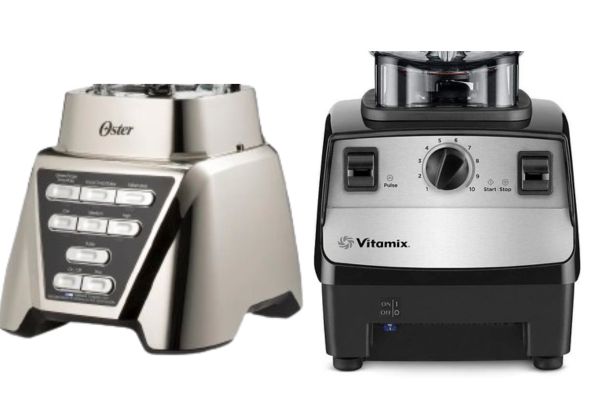
On the good side, the buttons are easy to press and the motor base has holes to let heat out. The main jar is made of thick glass, which feels strong and sturdy. The plastic personal jar also has a lid that can be closed and opened, which is handy for taking drinks on the go.
However, when you look closer, you can see some problems with the design. The gear on the motor base is square, but it fits into a star-shaped hole on the jar, which can make it hard to put the jar on the base.
This can also cause the gears to wear out faster. The blade assembly also feels loose and might not be well-made. The blades are held in place by a rubber ring that doesn’t fit tightly when it’s not attached to a jar, which can cause problems when blending. There’s also a small gap between the ring and the metal plate that can trap food and make cleaning harder.
In contrast, the Vitamix 5300 is very well-made. It’s mostly made of metal and plastic, which feels strong and solid. The power cord is long and thick, making it easy to move the blender around without getting it tangled. Overall, the Vitamix 5300 feels like a high-quality product.
Blade Assembly and Speed Comparison
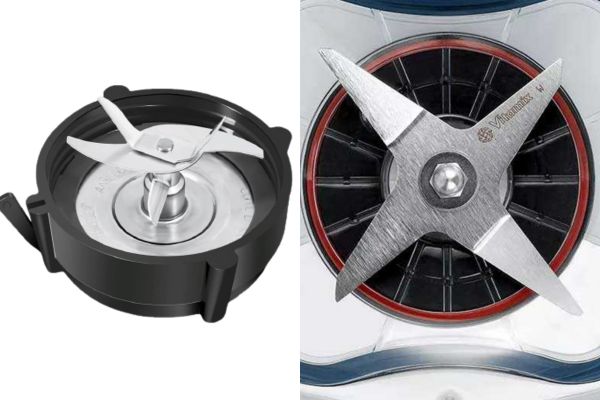
Both the Oster 1200 and Vitamix 5300 have sharp blades, which is essential for efficient blending. However, the Oster 1200 has six blades, while the Vitamix 5300 has four. The extra blades in the Oster 1200 might provide more thorough blending, but it’s not a guarantee.
One of the most significant advantages of the Oster 1200 is its removable blade assembly. This means you can easily take it out and wash it in the dishwasher, making cleaning a breeze. The Vitamix 5300, on the other hand, has blades that are not designed to be removed from the jar when you clean it. While you can service it thanks to its nut assembly, removing the blades voids the warranty and isn’t recommended by the manufacturer. This means you’ll have to hand-wash the blades, which can be a hassle.
The Oster 1200’s blade assembly is also held in place with a rubber gasket, making it easy to disassemble the blender for cleaning. This is a significant advantage when it comes to maintenance and upkeep.
The manufacturer of the Oster 1200 also highlights its ‘dual-direction technology,’ which allows the blender to reverse its blending direction to clear any jams. However, this feature wasn’t noticeable during testing, and you can’t manually activate it. It’s unclear how effective this feature really is.
When it comes to speed, the Oster 1200 has a minimum speed of 4,500 RPM and a maximum speed of 18,000 RPM, with a power output of 1,200 W. The Vitamix 5300, on the other hand, has a minimum speed of 1,400 RPM and a maximum speed of 22,500 RPM, with a power output of 1,640 W. The Vitamix 5300 has a more extensive range of speeds, which can be beneficial for achieving specific consistencies.
In terms of speed adjustment, the Oster 1200 has a wide range of speed settings, although you have limited control over the speed because there are only three presets, plus pulse mode. The blending speed is the fastest when you’re using pulse mode. The Vitamix 5300, on the other hand, has a wide range of speed settings, so you can fine-tune the blending speed to suit different recipes.
It’s also worth noting that neither blender has speed adjustment based on jar type. This means you’ll have to adjust the speed manually depending on the jar you’re using.
Performance Comparison
Soup Testing
The Oster Pro 1200 blender is a great choice for soups because it can handle hot ingredients directly from the pot or pan. This means you can blend your soups right after cooking, without having to let them cool down first. It also does a great job of blending fibrous ingredients like kale and broccoli, producing silky, pureed soups and sauces. And, when it comes to cleaning, the Pro is a breeze. It’s easy to wash and maintain, making it a great choice for busy home cooks.
However, the Pro 1200 does have one major drawback: it’s not very sturdy. This means it might not be able to withstand heavy use, and you might need to replace it sooner rather than later. But, if you’re looking for a blender that’s easy to use and can handle hot soups, the Oster Pro 1200 is a great choice. It scores an impressive 88 for soups, making it a great option for anyone who loves a good bowl of soup.
On the other hand, the Vitamix 5300 is a powerhouse when it comes to soups. This well-built blender can hot blend ingredients, and its large capacity 64-ounce main jar is ideal for making big batches of your favorite soups. This means you can make a big batch of soup on the weekend and have leftovers for the rest of the week. The Vitamix 5300 also makes a virtually perfectly smooth puree with ingredients like kale, meaning it can make a well-blended vegetable soup.
One of the biggest advantages of the Vitamix 5300 is its ability to handle tough ingredients. It can blend hot soups, frozen ingredients, and even make hot sauces from scratch. This makes it a great choice for home cooks who like to experiment with new recipes and ingredients. And, while the jar and lid are easy to clean by hand, they aren’t dishwasher-safe, which might be a drawback for some users.
In terms of scores, the Vitamix 5300 comes out on top, with a score of 95 for soups. This is no surprise, given its impressive performance and ability to handle tough ingredients. But, the Oster Pro blender is still a great choice, especially for those who want a blender that’s easy to use and clean.
Fibrous Ingredients Blending Test
The Oster 1200 is a fantastic choice for processing small batches of fibrous ingredients. Using the personal jar, it’s incredibly easy to make a single-serve smoothie with tough ingredients like kale. The result is an extremely smooth blend with almost no texture or graininess left behind. This is perfect for those who want to make a quick and healthy smoothie on-the-go.
On the other hand, the Vitamix 5300 is outstanding for processing big batches of fibrous ingredients. When you fill the jar to its full capacity, it can make a virtually perfectly smooth puree of ingredients like kale for a big batch of smoothies or soup. The best part? There’s no issue with ingredients splashing up the sides of the jar, making the process exceptionally easy and hassle-free.
However, when it comes to processing small batches of fibrous ingredients, the Vitamix 5300 has a slight drawback. The jar’s wide shape can be a downside when working with small amounts of ingredients, as food tends to splash up the sides of the jar even at low speeds. This means you’ll need to stop and scrape the jar with a spatula, making the process a little harder than it is with blenders like the Vitamix 5200 or Vitamix Ascent Series A3500. These blenders come with smaller or narrower jars, which make it easier to blend small batches without the hassle.
Speaking of the Vitamix 5200 and Vitamix A3500 blender, they’re both fantastic choices for processing fibrous ingredients. They offer an extremely smooth texture and can handle both small and large batches with ease. The narrower jars make it easier to blend small amounts of ingredients without the hassle of food splashing up the sides.
In terms of overall performance, the Vitamix 5300 takes the lead with a near-perfect score of 99.9 for both fibrous ingredients processing and texture. The Oster 1200 comes in second, with a score of 96 for both categories. The Vitamix 5200 and Vitamix A3500 Ascent Series follow closely behind, with scores of 99.9 and 99.5, respectively.
Nut Butter Making Test
The Oster Pro 1200 is a great choice for making nut butter, but it’s not the most straightforward process. You’ll need to stop the blender, take off the lid, and stir the ingredients a few times to keep everything moving. This can be a bit of a hassle, but after around four or five minutes of blending, you’ll be rewarded with smooth, easily spreadable nut butter. However, you may notice a few little unprocessed pieces trapped under the blades, which can be a bit annoying.
On the other hand, the Vitamix 5300 is fantastic for making nut butter. While you may need to scrape the sides of the jar with a spatula to get all the nuts incorporated, the end result is well worth the effort. In around three minutes, you’ll have a smooth, slightly sticky almond butter that’s easy to spread. The Vitamix 5300’s powerful blades and advanced motor make quick work of even the toughest nuts, leaving you with a creamy and delicious nut butter.
One of the key differences between these two blenders is the level of effort required to make nut butter. The Oster Pro 1200 requires a bit more manual intervention, while the Vitamix 5300 does most of the work for you. If you’re looking for a blender that can handle nut butter with ease, the Vitamix 5300 is the clear winner.
In terms of overall performance, the Vitamix 5300 takes the lead with a score of 91.5 for nut butter preparation and 96.5 for nut butter texture. The Oster blender machine follows closely behind, with a score of 70 for nut butter preparation and 91 for nut butter texture.
Easy to Use Comparison
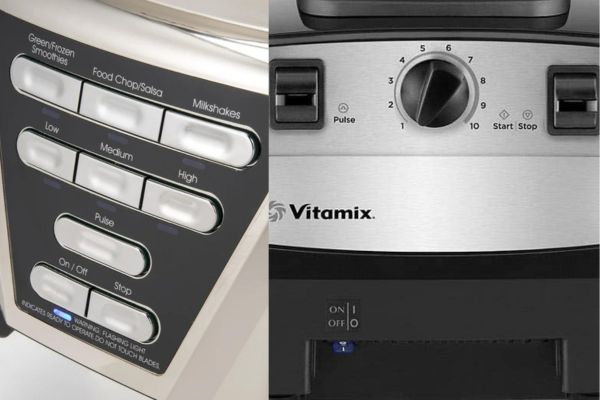
The Oster Pro 1200 is designed with simplicity in mind, making it easy to use right out of the box. The motor base features buttons for three speed presets: ‘Low’, ‘Medium’, and ‘High’. These presets allow you to switch between different blending speeds quickly and without any guesswork. In addition to the speed presets, there’s a dedicated pulse mode button. The pulse mode delivers the fastest blending speed, which is great for tasks that require short bursts of power, like crushing ice or chopping ingredients coarsely.
What makes the Pro 1200 blender particularly user-friendly is the inclusion of three blending programs: ‘Green/Frozen Smoothies’, ‘Food Chop/Salsa’, and ‘Milkshakes’. These programs take the guesswork out of blending by automatically adjusting the speed and duration to suit the task at hand. Whether you’re making a frozen smoothie, chopping vegetables for salsa, or blending a creamy milkshake, you can get started with the press of a button. There’s no need to worry about finding the perfect speed or timing— the blender does it for you.
A thoughtful safety feature on the Oster Pro 1200 is the on/off button. You must press this button to turn the blender on before it will run, adding an extra layer of safety. Additionally, a light flashes when the blender is ‘on,’ so you can easily tell when it’s ready to go.
On the other hand, the Vitamix 5300 offers a more minimalist approach to its controls. Instead of multiple buttons and programs, the Vitamix 5300 has a single speed dial. This dial allows you to make small adjustments to the speed, giving you more control over the blending process. Whether you’re starting on a low speed to blend soft ingredients or cranking it up for tough tasks, you can fine-tune the speed to match your needs.
In addition to the speed dial, the Vitamix 5300 has a pulse mode, which you activate with a switch. This pulse mode is handy for tasks that require precision, like chopping ingredients or creating chunky textures. There’s also an on/off toggle switch that must be turned ‘on’ before the blender will run, similar to the safety feature on the Oster Pro 1200.
One key difference between these two blenders is the level of automation they offer. The Oster Pro 1200 is equipped with pre-set blending programs, which makes it easier for users who prefer a more hands-off approach. You can select a program and let the blender handle the rest, which is convenient for those who don’t want to worry about speed adjustments or timing. This feature is especially helpful for beginners or anyone who values convenience.
Clean Process Comparison
The Oster blender is a breeze to clean, with a score of 91 in our cleaning test. The secret to its ease of cleaning is the simplicity of the process. All you need to do is add warm water and soap to the jar, run the blender on high, and let the soap do its magic. After that, you can use a sponge to wipe down the jar and blades, and you’re good to go. The best part? The blade assembly can be removed from the jar, making it easy to clean those hard-to-reach areas.
On the other hand, the Vitamix 5300 blender is also easy to clean, but it requires a bit more effort. With a score of 74.5 in our cleaning test, it’s still a relatively straightforward process, but you’ll need to use a brush or sponge to wipe down the underside of the lid, the inside of the jar, and its non-removable blades. This can be a bit more tedious than the Oster blender, but it’s still a manageable task.
One key difference between these two blenders is the design of the blade assembly. The Oster blender’s removable blade assembly makes it easy to clean, while the Vitamix 5300’s non-removable blades require more elbow grease to get clean. If you’re looking for a blender that’s easy to clean and maintain, the Oster blender might be the better choice.
Noise Level Comparison
The Oster 1200 watt blender is a loud blender, generating 97.3 decibels (dba) during blending. While it’s not the quietest blender on the market, it’s not the loudest either. In fact, many full-size blenders we’ve tested make less noise at maximum speed, including the Kitchenaid k150 blender and the Hamilton Beach Professional Quiet Shield Blender. So, if you’re looking for a blender that’s relatively quiet, the Oster 1200 watt might not be the best choice.
On the other hand, the Vitamix 5300 blender is a whole different story. It’s a lot louder than the Oster 1200 watt, generating a whopping 99.5 dba during blending. That’s a significant difference, and it means that the Vitamix 1640 Watts blender can be downright irritating to stand next to for very long. In fact, it’s even louder than some other Vitamix models, like the Vitamix 7500 or Vitamix 5200.
So, why is the Vitamix 5300 so much louder than the Oster 1200 watt? It’s probably due to its powerful motor, which is designed to handle tough blending tasks with ease. While that’s great for blending performance, it’s not so great for your ears. If you’re looking for a blender that’s quiet and won’t disturb the whole household, the Vitamix 5300 might not be the best choice.
Final Verdict
So, which blender is the winner? After comparing the Oster Pro 1200 and Vitamix 5300, it’s clear that both blenders are powerful and versatile. But there are some key differences.
If you’re on a budget and want a blender that’s easy to use and clean, the Oster Pro 1200 is a great choice. It’s a powerful blender that can handle tough ingredients and delivers smooth results.
But if you’re willing to invest in a high-end blender, the Vitamix 5300 is the way to go. It’s a more advanced blender with more features and settings, and it’s perfect for serious cooks and blender enthusiasts.
Ultimately, the choice between the Oster Pro 1200 and Vitamix 5300 depends on your budget and blending needs. Both blenders are great options, but they cater to different types of users.

